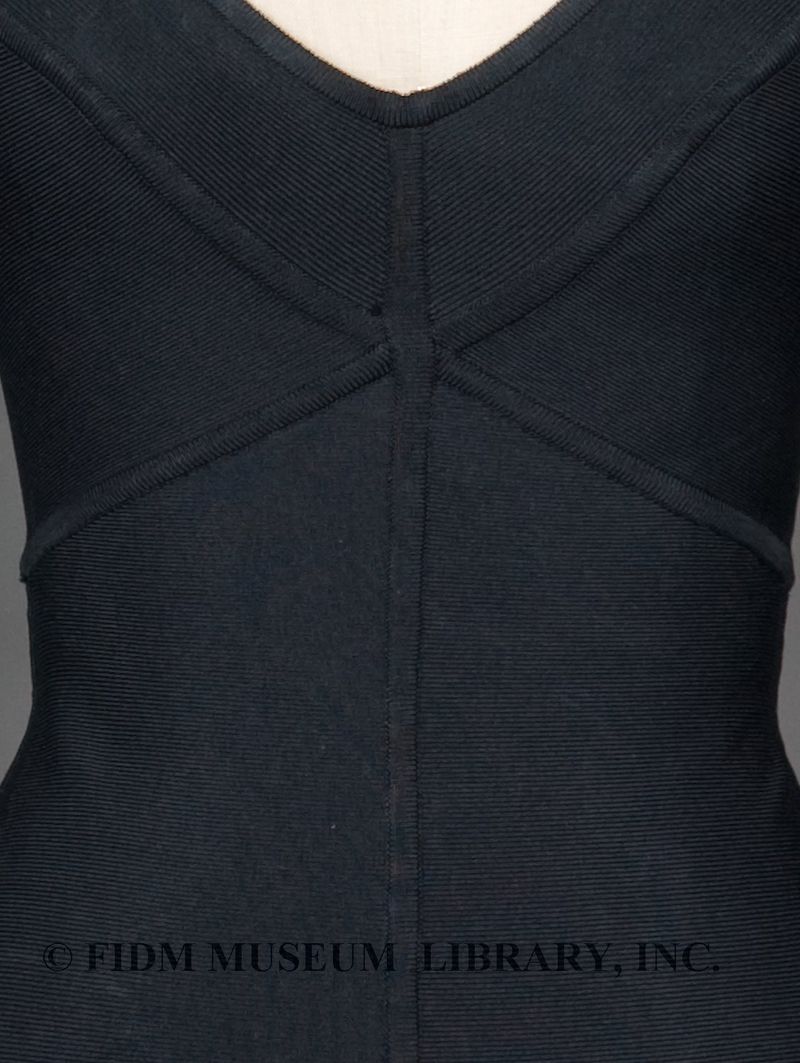Herve Leger's signature bandage dresses consist of elastic bands wrapped round and round the body, sometimes with a curved band strategically placed at bust or hips for emphasis. Sewn horizontally like the funeral wrappings of a mummy, the elastic bands sculpt the body as would a girdle or corset. The resulting "tight and steamy" fit of a Leger bandage dress was not for the faint of heart.1 Leger's glamorization of the female body signalled the emergence of the strong, sexy and slightly transgressive aesthetic that would influence fashion throughout the 1990s.
Leger first introduced the bandage dress about 1992, a few years after he took note of discarded stretchy elastic bands in a garbage can at a clothing factory. Leger was probably working for Charles Jourdan at the time, having previously worked at Chanel, Fendi, Chloe, Diane Von Furstenberg and Lanvin. Leger's solo collections were invariably riffs on the bandage theme, with color, length, band orientation, and neckline providing variety. This black mini jumpsuit showcases Leger's iconic second-skin fit.
 Mini Jumpsuit
Mini Jumpsuit
Herve Leger
1991-92
Gift of Nancy Riegelman
2006.602.2
Though Leger achieved almost immediate success with his bandage dresses, the subsequent arc of his career can be read as a cautionary tale about the economic underpinnings of the fashion industry. Working in the haute couture tradition, each Leger bandage dress was sewn by hand and required from 16 hours to 2 weeks to complete. Financial backing from the Seagram Company Ltd. allowed Leger to expand into ready-to-wear and to present more lavish runway presentations. In 1998, the relationship ended and Leger lost the financial backing of the Seagram Company. Within a few months, however, BCBG Max Azria purchased Herve Leger. In April 1999, BCBG Max Azria forced Leger out, stating that the "new team in place could not work with this person.'' 2 As his trademarked company was eponymous, Leger simultaneously lost his name and his livelihood.
Despite this setback, Leger didn't leave fashion behind. In 2000, he changed his name to Herve Leroux, and opened a small atelier in Paris. Working with a staff of four, Leroux began creating custom garments for a select clientele. In addition to creating his own designs, Leroux has also acted as design consultant for undergarment brand Wolford and filled a short term as head designer at Guy Laroche (2004-2006). None of Herve Leroux's designs incorporate body-sculpting elastic bands; in a April 2007 Vogue interview, Leroux claimed to have developed an interest in soft drapery.
Popular in the 1990s, the Leger bandage dress made a comeback in 2007/8. Vintage bandage dresses were donned by celebrities including Victoria Beckham and Keira Knightly. The renewed popularity of Herve Leger was given additional fuel when BCBG Max Azria relaunched the brand with a runway fashion show in 2008. Subsequent Max Azria for Herve Leger collections have proved popular, possibly because they adhere to the well-defined formula created by Leger in the early 1990s: strong lines and skin-tight fit.
1 "Paris, Veterans Day" Women's Wear Daily. 10 March 1994: 4.
2 Weisman, Katherine. "Leger Ousted After Clash with Azria Team." Women's Wear Daily. 8 April 1999: 14.



Thanks for the nice post . I really like it! 😉